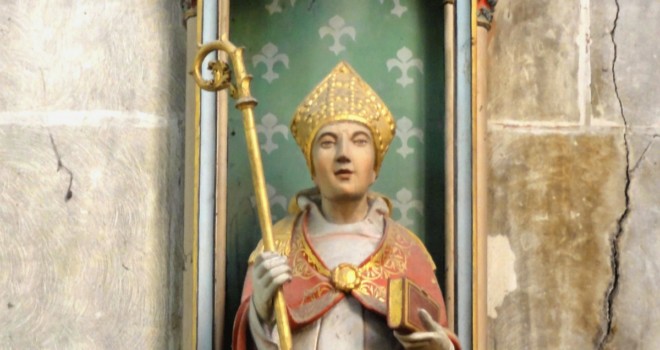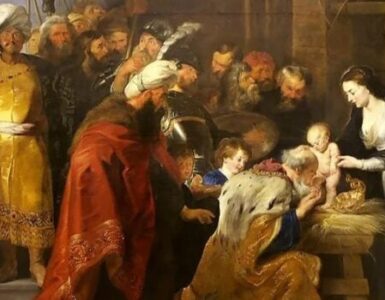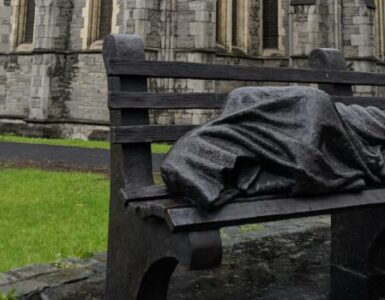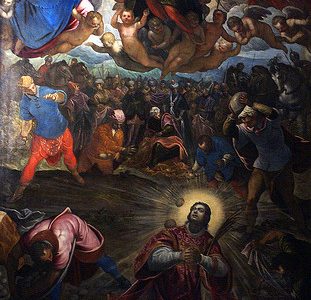“We can live without drugs and alcohol, but…people are more complicated than substances.”
St. Samson was a big deal. Born in Wales, educated by monks, and seemingly destined for leadership, Samson was “perhaps the most important British missionary of the 6th century,” according to David Farmer, and “an excellent example of the wandering Celtic monk-bishop.” He established new abbeys, reformed older ones, preached the Gospel boldly, and ably led the flocks entrusted to him.
Although he pined for a hermit’s life in the wilderness, Samson ended his days in Dol, Brittany, where he established a monastic missionary outpost and served as an irregular episcopal ordinary. We might not be very familiar with St. Samson in the States, but his feast (July 28) is celebrated throughout the British Isles and beyond, and there are numerous European parishes named for him. A stellar saint, to be sure!
But I’m guessing there’s a shadow side to his story that’s easy to overlook.
After his initial formation and ordination in the abbey of Llanwit, Samson transferred to the community on Caldey Island where he took up duties as cellarer — a kind of steward of the monastery’s foodstuffs and drink. This is significant, because Caldey’s Abbot, St. Pyr, seems to have had a bit of a drinking problem — and the cellarer would’ve been the first to know about it. The annals tell of Pyr getting so snockered one night that he stumbled into a well and died as a result of the fall. And since such spectacular episodes of intoxication are highly unlikely to be isolated events, Abbot Pyr probably had been battling the bottle long before his mortal mishap.
Now, Pyr’s lack of temperance and unseemly end might cast some doubt on the suitability of his saintly designation — a title ascribed to him by tradition, rather than formal canonization. We have to remember, though, that those who struggle with substance abuse and addiction are still called to become saints and, what’s more, can become saints. Truly, everyone can become a saint — even me, even you — and God gives us the grace to do so.
But besides questions related to Pyr’s habits and holiness, what fascinates me about his story is that the abbot’s propensity to over imbibe must’ve been an open secret in the cloister. Sure, Samson the cellarer knew, but so did everybody else — how could they not? A monastery is an intimate family, after all, and the abbot is the dad — in Pyr’s case, a dad crippled by addiction. How did Samson and his confreres deal with that?
It seems to me that it could very well have been a classic case of codependency.
Codependency is a controversial term these days, but it was all the rage not that long ago. It can apply to almost any flavor of dysfunctional family system, but it’s especially associated with alcoholic homes.
I know of it firsthand because my dad was an alcoholic. Like so many in that situation, I was clueless about the chaos at home and its connections to the booze. The family strife, the erratic behaviors, the cover-ups and pain — I naturally assumed that it was all normal. That it was what all families experienced. Why would I think otherwise?
Then my mom talked to me one night about something called Al-Anon — an organization that provides support for folks who live with alcoholics. She’d been in touch with them and was getting involved, looking for help. “There’s also a group for teenagers,” she told me. “Maybe you should consider going.”
I never did. Somehow, I still managed to get through high school and college, and then launched into the adventure of my own adulthood. I moved here and there, became a Catholic, dated off and on, and tried my hand at various pursuits. But there was definitely a gnawing void within – I was hurting, in agony.
At some point, somebody (my mom? a co-worker?) got me to read Janet Woititz’s 1983 book, Adult Children of Alcoholics, and it was a game changer. What she described — the enabling, the duplicity, the stress, the craziness — really resonated. It prompted me to finally reach out for help — like my mother did so many years before — and I was able to separate my problems from my dad’s. He continued to struggle with his addiction, alternating between sobriety and drinking the rest of his life (rest in peace, dad), but I got to the place where I could see it as his struggle, not mine.
I loved my father, although sometimes I regret not loving him better — not to mention plenty of other regrets. Most of the time, however, thanks to writers like Woititz and a host of counselors, I can focus on the present and today’s challenges – the ones associated with being a husband, father, worker, and would-be saint. That’s plenty to deal with, and I’d like to think that my efforts honor my dad and the best parts of his legacy that live on in me.
St. Samson seems to have gone through a similar transformation.Whatever brand of codependent exigencies that preceded Pyr’s tragic demise, Samson stepped up and set a new course afterwards. He took up the abbot’s crozier and attempted to clean house at Caldey, but the community’s dysfunctional patterns were too entrenched and, in the words of Farmer, Samson “accordingly resigned the abbacy in disgust.” That action freed him up to seek out new opportunities to exercise his gifts, which led to the many foundations and apostolates he became associated with.
Clearly Samson strived to become the spiritual father that the impaired Pyr couldn’t quite manage. He left the brokenness of his past behind and forged a new path, striving to draw everyone he encountered closer to Christ. It seems that wherever he went, flourishing followed, and the honor in which his name is held to this day is testimony to how God worked in and through him.
“Ask and you will receive,” Jesus assures us in the Gospel today, “seek and you will find; knock and the door will be opened to you.” Those are precisely the promises that enabled St. Samson to move on from his unhealthy roots to a more glorious future.
They’re the same promises that we broken folk can rely on today.
✠
image: Pierre Poschadel [CC BY-SA 3.0], via Wikimedia Commons













